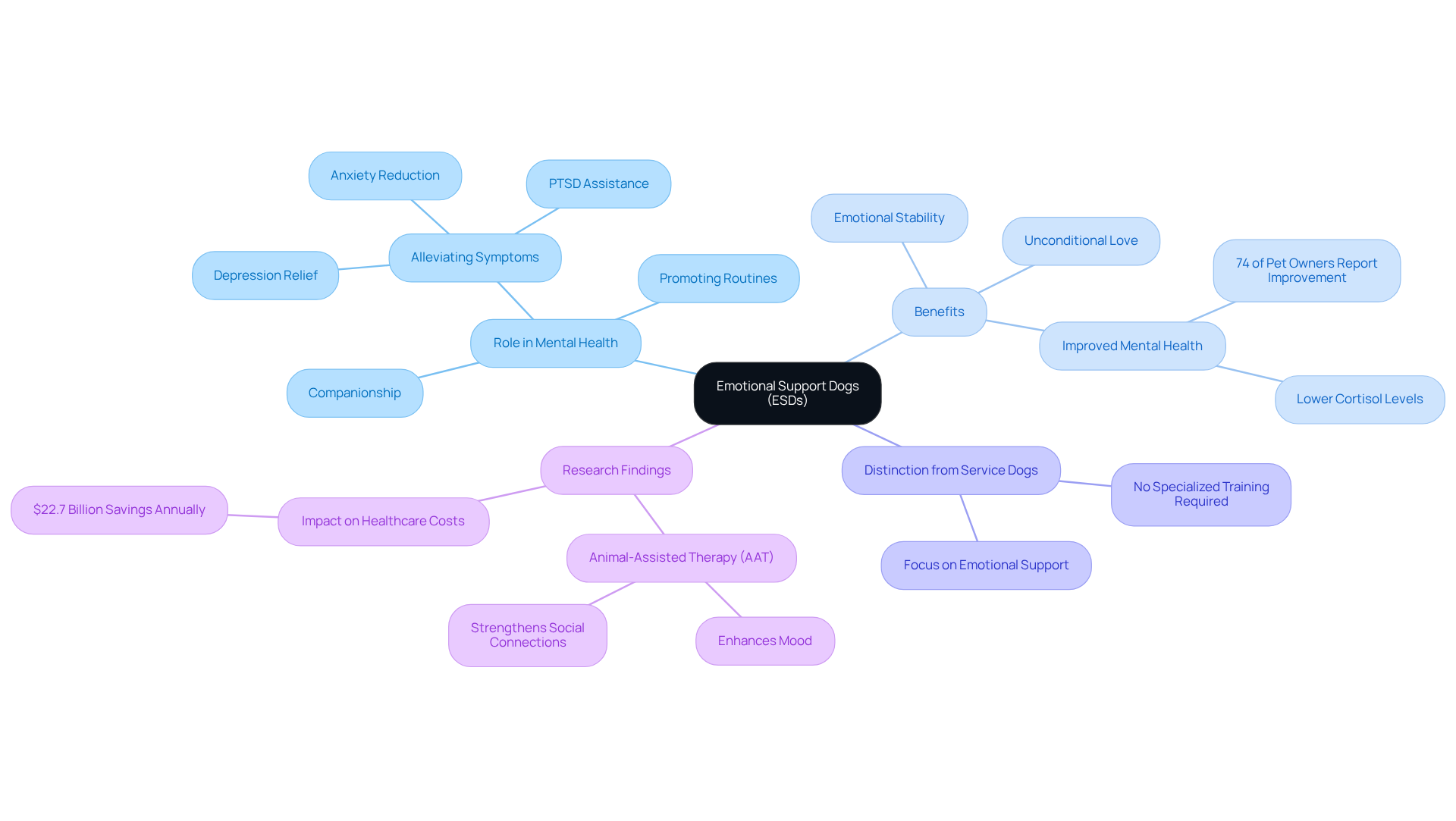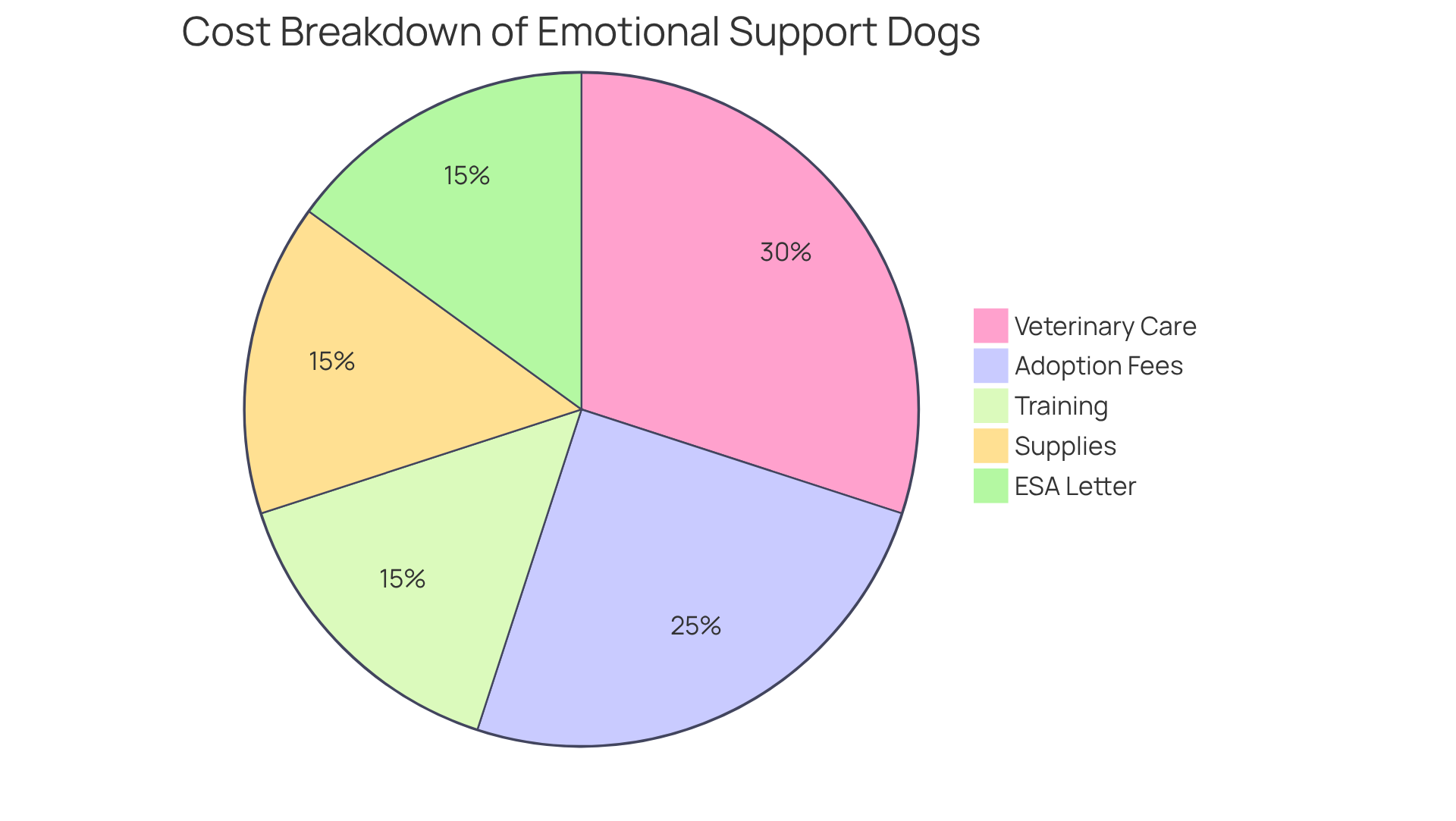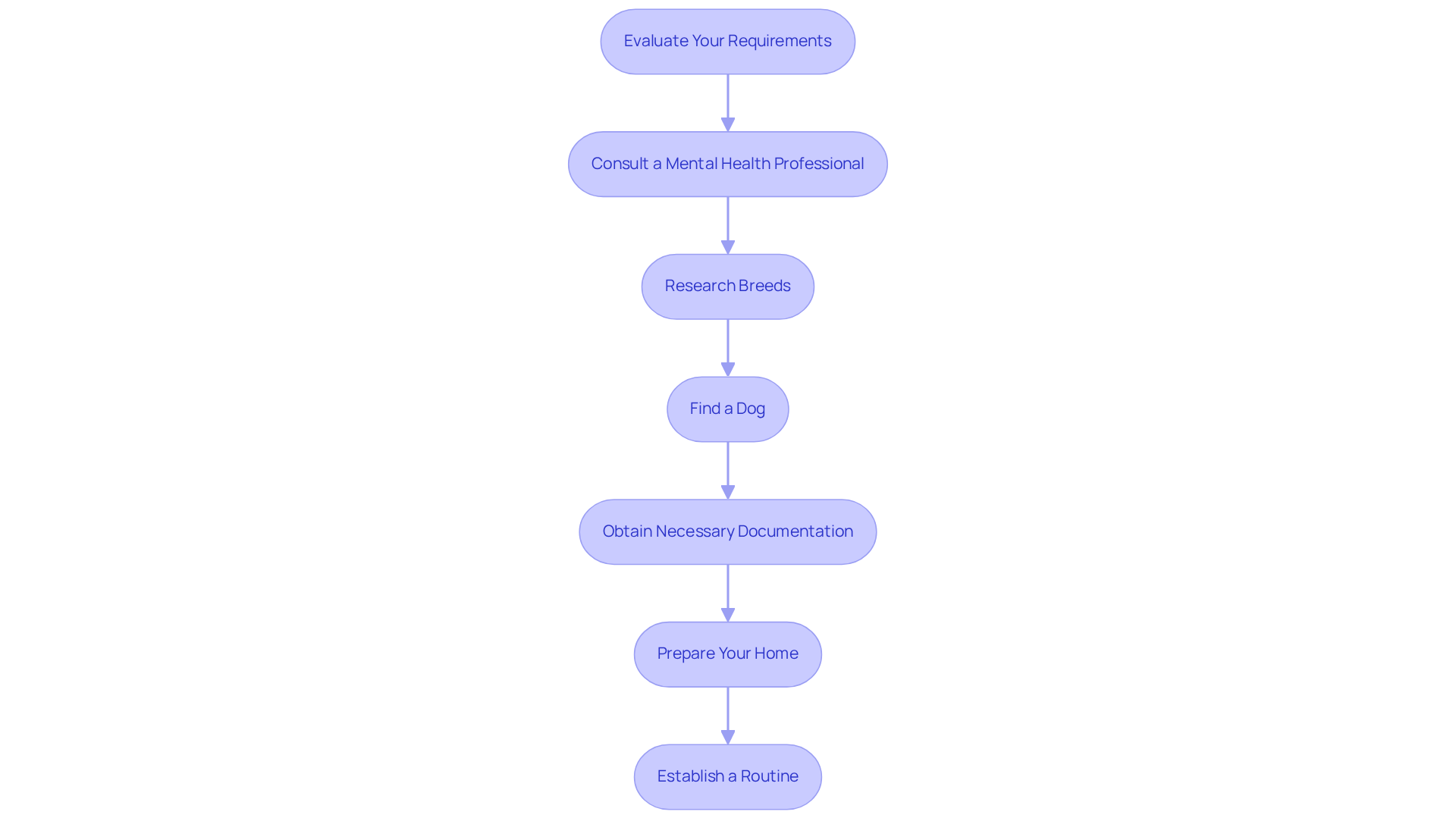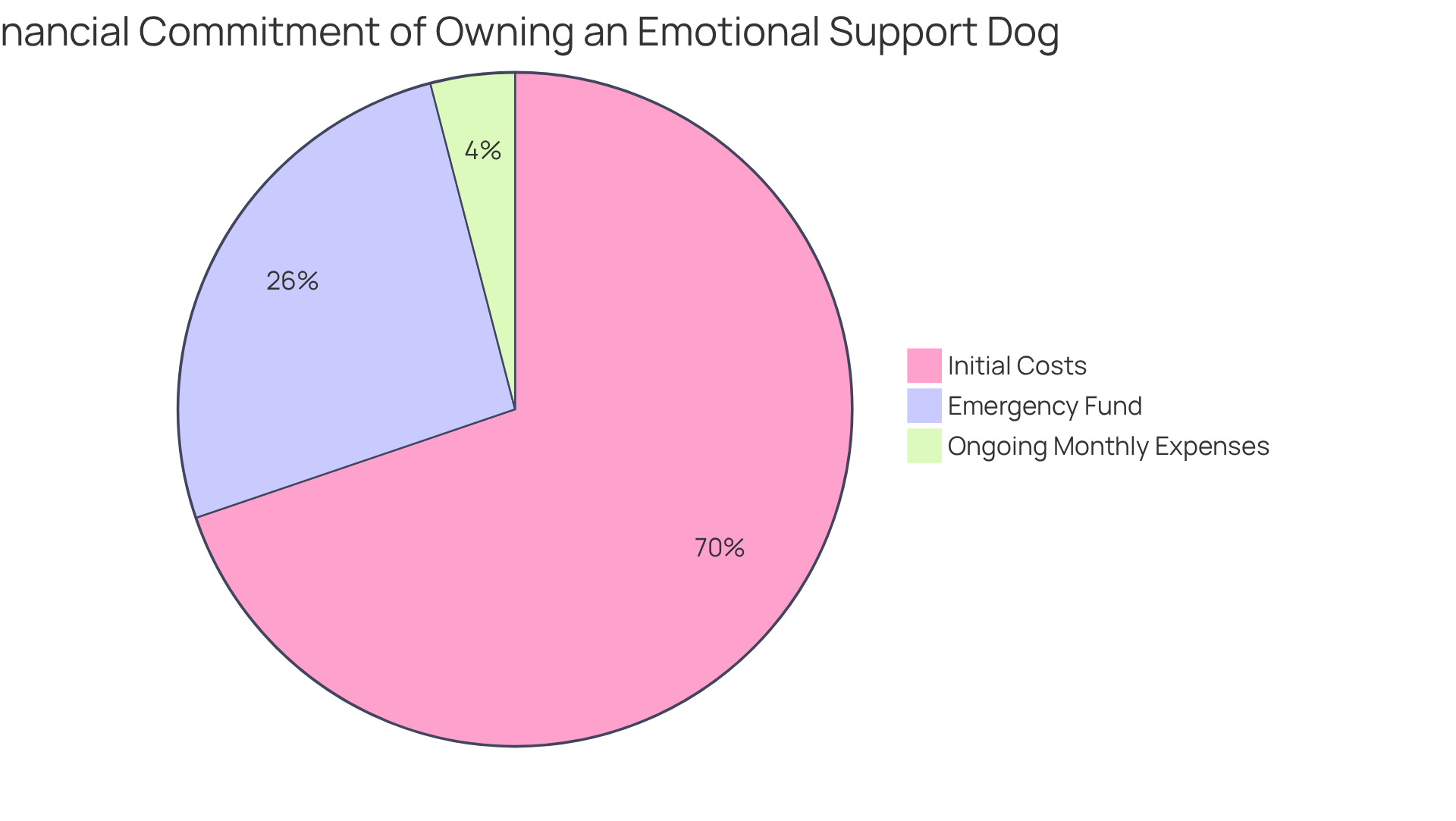

How Much Are Emotional Support Dogs? Costs and Steps Explained
by Lena Park
Last updated: July 11, 2025
Verified and Approved by:
Angela Morris,
MSW, LCSW
Fact Checked

Overview
Caring for an emotional support dog is a significant commitment, with initial costs typically ranging from $500 to $3,000. On top of that, ongoing monthly expenses can average between $280 and $740. These figures can vary based on factors such as:
- Adoption fees
- Veterinary care
- Necessary supplies
It’s essential to recognize the emotional weight of these financial responsibilities. By budgeting for both initial and recurring expenses, prospective owners can prepare themselves for the journey ahead, ensuring they are ready to embrace the love and companionship that an emotional support dog offers.
Introduction
Emotional support dogs have become essential companions for those navigating the complexities of mental health challenges, offering comfort and stability during difficult times. This guide explores the various aspects of acquiring an emotional support dog, beginning with an understanding of their unique role in enhancing mental well-being.
It also addresses the financial commitments that come with welcoming such a loyal companion into one’s life. With a diverse range of costs linked to adoption, care, and necessary documentation, many prospective owners might find themselves pondering: how can one reconcile the emotional benefits of these devoted friends with the financial realities of integrating them into their lives?
Define Emotional Support Dogs and Their Role in Mental Health
Assistance animals (ESDs) play a vital role in providing comfort and companionship to individuals facing psychological or mental challenges. Unlike service dogs, which are specifically trained to perform tasks for individuals with disabilities, ESDs primarily offer emotional support and companionship. Their presence can significantly alleviate symptoms of anxiety, depression, PTSD, and other mental health conditions. Research indicates that regular interaction with pets can lower cortisol levels, a marker of stress, and enhance overall mental well-being. For instance, studies reveal that 74% of pet owners report improved mental health due to their pets, underscoring the therapeutic benefits of ESDs.
The soothing presence of a support dog can ease feelings of loneliness and foster a sense of security, particularly for those who may struggle with social interactions or experience heightened anxiety. Moreover, ESDs promote healthy routines and provide unconditional love, which is essential for emotional stability.
Understanding the distinction between ESDs and therapy animals is crucial. While service dogs are trained to perform specific tasks, such as guiding individuals with visual impairments or alerting those with hearing loss, ESDs do not require specialized training. Their primary role is to offer psychological comfort and assistance.
Recent studies highlight the significance of ESDs in mental health care. For example, animal-assisted therapy (AAT) has been shown to enhance mood and strengthen social connections, illustrating the potential benefits of ESDs in therapeutic environments. As awareness of the mental health advantages of therapy animals continues to grow, more individuals are recognizing the positive impact these companions can have on their lives. Clients can expect to receive their official ESA letter within 24 hours of approval, ensuring timely support for those in need of companionship. As one satisfied client, Linda S., expressed, “Applying for an ESA through Wellness Wag was the best decision I made. It was an effortless process and the team was very professional.” This testimonial reflects the exceptional service and swift approval that Wellness Wag offers for Emotional Support Animal letters. Additionally, Wellness Wag provides flexible payment options starting at $32.25, which can help those seeking psychological assistance understand how much are emotional support dogs.

Break Down the Costs of Obtaining an Emotional Support Dog
The expenses related to how much emotional support dogs can differ significantly depending on various factors, and it’s important to understand these costs as you navigate this journey. Here’s a detailed breakdown of potential expenses that you might encounter:
-
Adoption Fees: Adopting from a shelter typically incurs fees ranging from $50 to $200. However, the initial expenses of adopting a dog can range from $670 to $2,320, depending on the breed and the policies of the adoption organization. In contrast, purchasing from breeders can be significantly more expensive, often between $500 and $3,000, depending on the breed and lineage.
-
Veterinary Care: Initial veterinary visits for vaccinations, spaying/neutering, and health checks may range from $100 to $300. Ongoing care, including annual check-ups and vaccinations, generally adds another $200 to $500 per year. However, ongoing care for an ESA averages between $500 and $1,500 annually, reflecting the importance of budgeting for regular veterinary visits. Furthermore, considering pet insurance can assist in reducing unforeseen veterinary expenses, as 42% of pet owners find it challenging to manage unexpected vet bills averaging between $800 and $1,500. Have you thought about how these costs might affect your ability to care for your new companion?
-
Training: While emotional support dogs do not require specialized training, basic obedience training is highly recommended. This may require approximately $100 to $500, ensuring that your dog is well-behaved and responsive, which can make your experience more enjoyable.
-
Supplies: Initial supplies such as food, a bed, leash, and toys may require around $100 to $200. Monthly expenses for food and supplies typically range from $50 to $150, depending on your dog’s size and dietary needs. It’s essential to consider these ongoing costs as part of your commitment to your new friend.
-
ESA Letter: Acquiring a valid ESA letter from a licensed mental health specialist typically ranges from $150 to $200. However, with Wellness Wag, you can start the process for as low as $32.25, thanks to interest-free payment plans that allow you to divide your payment into manageable installments. This letter is crucial for securing legal acknowledgment of your assistance animal, especially in housing situations with pet limitations. Remember, this step can be a vital part of ensuring you receive the support you need.
Overall, when considering how much emotional support dogs cost, the starting expenses of obtaining a companion dog can vary from $500 to $3,000, with recurring monthly costs averaging between $280 and $740. Understanding these financial commitments is crucial for prospective pet owners, as it helps ensure that you are prepared for the responsibilities of pet ownership. Your journey towards companionship and emotional support is significant, and being informed about these aspects will help you embrace it with confidence.

Outline the Step-by-Step Process to Acquire an Emotional Support Dog
Acquiring an emotional support dog involves several key steps that can truly enhance your well-being:
-
Evaluate Your Requirements: Take a moment to reflect on your feelings and psychological needs. Is a support dog the right choice for you? It’s heartening to know that approximately 88% of ESA owners report a positive mental health impact. This underscores the potential benefits of having an ESA, especially when considering how much emotional support dogs can cost, particularly since nearly half of Americans will face some form of mental or psychological disorder in their lives. Recognizing this can illuminate the vital role ESAs play in mental health care.
-
Consult a Mental Health Professional: Reach out to a licensed mental health professional who can assess your situation and determine your eligibility for an ESA. If approved, you will receive an ESA letter, which is crucial for accessing housing and travel accommodations. Keep in mind that some states require a 30-day client-provider relationship before an ESA letter can be issued. At Wellness Wag, we strive to make this consultation process straightforward and supportive.
-
Research Breeds: Think about which dog breeds align best with your lifestyle and personal needs. Some breeds are renowned for their calming presence, while others may bring more energy. Choose a breed that resonates with your requirements and emotional landscape.
-
Find a Dog: Decide whether to adopt from a shelter or purchase from a breeder. It’s essential that the dog you choose has a temperament that complements your psychological needs, as this can significantly shape your experience together.
-
Obtain Necessary Documentation: Once you have your ESA letter, keep it handy for housing or travel needs. Remember, landlords are required to respond to ESA requests within 10 days, which is vital for those seeking accommodations in pet-restricted housing. To streamline this process, consider taking our quick assessment at Wellness Wag to tailor our services to your assistance animal needs.
-
Prepare Your Home: Make your home a welcoming space for your new dog by gathering essential supplies and creating a safe environment. This thoughtful preparation can ease the transition for both you and your new companion, fostering a sense of security.
-
Establish a Routine: Create a daily routine that includes feeding, exercise, and bonding time. This structure will help your dog adjust to their new surroundings and enhance the psychological benefits of having an ESA, promoting both stability and companionship.
As you embark on this journey, remember that you are not alone. The companionship of an ESA can provide transformative support, making many wonder how much are emotional support dogs.

Discuss Financial Considerations and Budgeting for Emotional Support Dogs
Budgeting for how much emotional support dogs requires thoughtful planning to manage both initial and ongoing expenses. It’s important to consider the financial aspects involved in this rewarding journey.
Initial costs can vary significantly, ranging from $500 to $3,000. This includes adoption fees, veterinary care, and essential supplies. Allocating resources for these initial expenses is crucial to avoid any financial strain as you welcome your new companion into your life.
Ongoing expenses can accumulate quickly. Monthly costs for food, supplies, and veterinary care typically range from $50 to $150. On average, pet owners spend around $1,391 each year on their dogs. This highlights the importance of establishing a comprehensive monthly budget that incorporates these ongoing expenditures to ensure your financial stability while providing for your furry friend.
Unexpected veterinary expenses can arise from accidents or health issues, making it vital to have an emergency fund. A recommended amount to save is between $500 and $1,000, which can serve as a safety net for unforeseen medical costs. It’s concerning to note that over a quarter of pet owners (28%) have indicated that a vet bill of $499 or less could lead them into debt, underscoring the necessity of being prepared for such situations.
Pet insurance can be an invaluable resource for managing unexpected medical expenses. Given that the typical yearly expense of caring for a dog is around $1,391, having insurance can alleviate some financial pressures. It’s wise to explore different options to find one that aligns with your budget and coverage needs. Interestingly, nearly 78.8% of pet owners believe pet insurance is beneficial. However, 42% of dog owners without insurance cite high costs as the primary reason for not obtaining it, revealing a significant barrier to coverage.
In certain situations, costs associated with therapy animals may qualify for tax deductions. Consulting with a tax professional can help clarify which expenses may be claimed, potentially easing your financial burden.
By thoughtfully considering these financial aspects, including how much emotional support dogs cost and the potential barriers to insurance, you can better prepare for the responsibilities that come with owning one. This preparation not only ensures your pet’s well-being but also supports your financial health, allowing you to focus on the joy and companionship your new friend will bring.

Conclusion
Emotional support dogs are vital companions for individuals facing mental health challenges, offering comfort and fostering emotional stability. Their role goes beyond mere companionship; they are essential allies in navigating the complexities of anxiety, depression, and other psychological issues. For anyone considering this life-changing step, understanding the financial and logistical aspects of acquiring an emotional support dog is crucial.
The article highlights the multifaceted costs associated with obtaining an emotional support dog, from initial adoption fees to ongoing veterinary care and supplies. It emphasizes the importance of budgeting for both initial and recurring expenses, which can vary significantly based on different factors. Furthermore, the step-by-step guide outlines necessary actions to take, such as:
- Consulting a mental health professional
- Preparing for the arrival of a new furry friend
Ultimately, the journey to welcoming an emotional support dog is not solely about the financial commitment; it is also about the profound impact these companions can have on mental health. For those contemplating this path, it is imperative to approach it with careful planning and a clear understanding of the responsibilities involved. Embracing the companionship of an emotional support dog can lead to transformative benefits, enhancing emotional well-being and fostering a sense of security. Taking the first step towards this rewarding relationship could be one of the most significant decisions for improving overall mental health.
Frequently Asked Questions
What are Emotional Support Dogs (ESDs) and their role in mental health?
Emotional Support Dogs (ESDs) provide comfort and companionship to individuals facing psychological or mental challenges, alleviating symptoms of anxiety, depression, PTSD, and other mental health conditions.
How do ESDs differ from service dogs?
Unlike service dogs, which are specifically trained to perform tasks for individuals with disabilities, ESDs primarily offer emotional support and companionship without requiring specialized training.
What are the benefits of having an ESD?
ESDs can lower cortisol levels, enhance overall mental well-being, ease feelings of loneliness, foster a sense of security, promote healthy routines, and provide unconditional love, which is essential for emotional stability.
What does research say about the impact of pets on mental health?
Research indicates that regular interaction with pets can lower stress markers, and studies show that 74% of pet owners report improved mental health due to their pets.
How do ESDs contribute to therapeutic environments?
ESDs enhance mood and strengthen social connections, which illustrates their potential benefits in therapeutic settings, such as animal-assisted therapy (AAT).
How can individuals obtain an Emotional Support Animal letter?
Clients can expect to receive their official ESA letter within 24 hours of approval, ensuring timely support for those in need of companionship.
What is the process like for applying for an ESD through Wellness Wag?
The application process for an ESD through Wellness Wag is described as effortless and professional, with satisfied clients expressing positive experiences.
What are the payment options for obtaining an ESD letter through Wellness Wag?
Wellness Wag offers flexible payment options starting at $32.25 for those seeking psychological assistance related to Emotional Support Animals.
Certify Your Emotional Support Animal Today

Why You Can Rely on Us?
At Wellness Wag, we believe your pet deserves care rooted in both science and compassion. Each article is carefully researched, written in clear language for pet owners, and then reviewed by qualified professionals to ensure the information is evidence-based, current, and practical for real-life care. Our goal is to help you feel confident in making informed decisions about your pet’s health and well-being.
Reviewed by
Angela Morris, MSW, LCSW
Angela is a licensed clinical social worker with 20 years of experience in patient advocacy and community mental health. She has assisted numerous clients with ESA evaluations and brings a deep understanding of disability accommodations, ensuring that all information is accurate, supportive, and practical.

Written by :
Lena Park
Last Updated :
July 11, 2025












